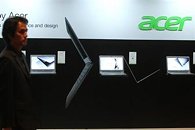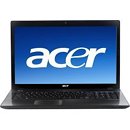Apr 10th, 2025 08:18 EDT
change timezone
Latest GPU Drivers
New Forum Posts
- Do you use Linux? (574)
- Asking before I mess up (19)
- Can you guess Which game it is? (66)
- Downgrading bios on asrock A320 board (4)
- TPU's Nostalgic Hardware Club (20215)
- Looking for input on fan placement for my Define R5 (10)
- Your PC ATM (35330)
- TechPowerUp RAM Latency Calculator Feedback (71)
- Problem "Vu meter Windows 11 24h2 missing" (2)
- Thermal testing two different size Gigabyte 5070 Ti cards - huge differences (20)
Popular Reviews
- The Last Of Us Part 2 Performance Benchmark Review - 30 GPUs Compared
- ASRock Z890 Taichi OCF Review
- MCHOSE L7 Pro Review
- Sapphire Radeon RX 9070 XT Pulse Review
- PowerColor Radeon RX 9070 Hellhound Review
- Upcoming Hardware Launches 2025 (Updated Apr 2025)
- Sapphire Radeon RX 9070 XT Nitro+ Review - Beating NVIDIA
- Acer Predator GM9000 2 TB Review
- ASUS GeForce RTX 5080 Astral OC Review
- Zotac GeForce RTX 5070 Ti Amp Extreme Review
Controversial News Posts
- NVIDIA GeForce RTX 5060 Ti 16 GB SKU Likely Launching at $499, According to Supply Chain Leak (174)
- MSI Doesn't Plan Radeon RX 9000 Series GPUs, Skips AMD RDNA 4 Generation Entirely (146)
- Microsoft Introduces Copilot for Gaming (124)
- AMD Radeon RX 9070 XT Reportedly Outperforms RTX 5080 Through Undervolting (119)
- NVIDIA Reportedly Prepares GeForce RTX 5060 and RTX 5060 Ti Unveil Tomorrow (115)
- Nintendo Confirms That Switch 2 Joy-Cons Will Not Utilize Hall Effect Stick Technology (100)
- Over 200,000 Sold Radeon RX 9070 and RX 9070 XT GPUs? AMD Says No Number was Given (100)
- Nintendo Switch 2 Launches June 5 at $449.99 with New Hardware and Games (99)
News Posts matching #Wistron
Return to Keyword Browsing
NVIDIA CEO Jensen Huang to Deliver Keynote Ahead of COMPUTEX 2024
Amid an AI revolution sweeping through trillion-dollar industries worldwide, NVIDIA founder and CEO Jensen Huang will deliver a keynote address ahead of COMPUTEX 2024, in Taipei, outlining what's next for the AI ecosystem. Slated for June 2 at the National Taiwan University Sports Center, the address kicks off before the COMPUTEX trade show scheduled to run from June 3-6 at the Taipei Nangang Exhibition Center. The keynote will be livestreamed at 7 p.m. Taiwan time (4 a.m. PT) on Sunday, June 2, with a replay available at NVIDIA.com.
With over 1,500 exhibitors from 26 countries and an expected crowd of 50,000 attendees, COMPUTEX is one of the world's premier technology events. It has long showcased the vibrant technology ecosystem anchored by Taiwan and has become a launching pad for the cutting-edge systems required to scale AI globally. As a leader in AI, NVIDIA continues to nurture and expand the AI ecosystem. Last year, Huang's keynote and appearances in partner press conferences exemplified NVIDIA's role in helping advance partners across the technology industry.
With over 1,500 exhibitors from 26 countries and an expected crowd of 50,000 attendees, COMPUTEX is one of the world's premier technology events. It has long showcased the vibrant technology ecosystem anchored by Taiwan and has become a launching pad for the cutting-edge systems required to scale AI globally. As a leader in AI, NVIDIA continues to nurture and expand the AI ecosystem. Last year, Huang's keynote and appearances in partner press conferences exemplified NVIDIA's role in helping advance partners across the technology industry.

NVIDIA Modulus & Omniverse Drive Physics-informed Models and Simulations
A manufacturing plant near Hsinchu, Taiwan's Silicon Valley, is among facilities worldwide boosting energy efficiency with AI-enabled digital twins. A virtual model can help streamline operations, maximizing throughput for its physical counterpart, say engineers at Wistron, a global designer and manufacturer of computers and electronics systems. In the first of several use cases, the company built a digital copy of a room where NVIDIA DGX systems undergo thermal stress tests (pictured above). Early results were impressive.
Making Smart Simulations
Using NVIDIA Modulus, a framework for building AI models that understand the laws of physics, Wistron created digital twins that let them accurately predict the airflow and temperature in test facilities that must remain between 27 and 32 degrees C. A simulation that would've taken nearly 15 hours with traditional methods on a CPU took just 3.3 seconds on an NVIDIA GPU running inference with an AI model developed using Modulus, a whopping 15,000x speedup. The results were fed into tools and applications built by Wistron developers with NVIDIA Omniverse, a platform for creating 3D workflows and applications based on OpenUSD.
Making Smart Simulations
Using NVIDIA Modulus, a framework for building AI models that understand the laws of physics, Wistron created digital twins that let them accurately predict the airflow and temperature in test facilities that must remain between 27 and 32 degrees C. A simulation that would've taken nearly 15 hours with traditional methods on a CPU took just 3.3 seconds on an NVIDIA GPU running inference with an AI model developed using Modulus, a whopping 15,000x speedup. The results were fed into tools and applications built by Wistron developers with NVIDIA Omniverse, a platform for creating 3D workflows and applications based on OpenUSD.
Notebook Shipments for 1Q23 Are Projected Reach 10-Year Low for First-Quarter Result, Says TrendForce
Due to the various major events that affected the global economy and politics, the overall demand for consumer electronics made a sharp downward turn in 2022, and global shipments of notebook (laptop) computers began to fall over the quarters. TrendForce's latest analysis finds that global shipments of notebook computers (from ODMs) reached just around 186 million units for 2022, showing a YoY drop of 24.5%. As for 2023, the outlook on the performance of the notebook computer market remains uncertain at this moment. TrendForce expects the YoY decline to moderate to about 7.8%, but shipments are projected to total only 171 million units.
Because market demand was anemic in 4Q22, promotional activities related to the traditional year-end peak season did not generate a lot of sales momentum. Looking at regional markets, notebook brands (PC OEMs) slashed prices in the US and China, but their sales results still did not meet expectations. This development was mainly attributed to factors such as high inflation suppressing consumers' disposable income. Since the sales results for 4Q22 were lackluster, efforts to get rid of the existing stockpile of whole devices might continue through 2Q23. Furthermore, order placements from channels are going to be much more restrained.
Because market demand was anemic in 4Q22, promotional activities related to the traditional year-end peak season did not generate a lot of sales momentum. Looking at regional markets, notebook brands (PC OEMs) slashed prices in the US and China, but their sales results still did not meet expectations. This development was mainly attributed to factors such as high inflation suppressing consumers' disposable income. Since the sales results for 4Q22 were lackluster, efforts to get rid of the existing stockpile of whole devices might continue through 2Q23. Furthermore, order placements from channels are going to be much more restrained.

Acer Working on 15-inch Ultrabook PC
After seeing market success with 11-inch and 13-inch ultrabooks (ultra-compact notebooks), Acer began working on a new, larger 15-inch ultrabook, which it plans to sell at a price-point of US $699. According to sources, Pegatron is the upstream ODM behind this model. Acer's current ultrabooks are manufactured on contract by Wistron. The sales of ultrabooks are expected to reach 250,000-300,000 units by the end of this year. Pegatron's total notebook shipments to reach 18.99 million units by the end of this year, with an annual growth of 22%, which will make it the fourth largest ODM by volume.

Acer to Downsize Two-Thirds in 2012
Today DigiTimes reported Acers Chairman JT Wang, announced that the company will be downsizing its product line two-thirds by the end of 2012. Mr. Wangs statement leaned this maneuver as more of a streamline process rather then a downsize citing he expected sales to increase by 10% or higher within the next year. Mr. Wang also stated that this downsize will not effect its outsourcing partners. However, Acer's major partners including Quanta Computer, Compal Electronics, Wistron and Pegatron Technology have decline to comment. One cannot help but wonder how many other manufactures will follow suit in these hard economic times.

Microsoft Tells ARM Partners to Pick Notebook Vendors
Windows (PC) will make its first transition to a machine architecture other than x86 in decades with Windows 8 Windows on ARM (WOA), and Microsoft wants to make absolutely sure that it has a well-oiled ecosystem in place to propel its growth. Currently, Microsoft picked three potent players among ARM processor vendors, Qualcomm and Texas Instruments (that have experience and can ship in Zerg volumes), and NVIDIA (which has demonstrated a lot of engineering potential with its latest Tegra products).
Microsoft reportedly asked the three ARM players to pick two notebook vendors each (one major, and one minor) with which they will work to develop some of the first WOA portable computing devices. Qualcomm selected Samsung and Sony, Texas Instruments chose Toshiba and Samsung, while NVIDIA chose Acer and Lenovo. Among these, Samsung, Toshiba, and Lenovo are the major partners. Surprisingly, Taiwan-based companies have an insignificant role in this ecosystem. ASUS, which has thus far been the largest client of NVIDIA for Tegra processors, has been left out. Now that downstream partners are selected, upstream ODMs such as Quanta Computer, Compal Electronics, Wistron and Pegatron Technology, which manufacture for those companies, are getting their R&D teams in shape to compete for the next-generation platform. The finishing line of ARM's marathon run to get into PCs is in sight.
Microsoft reportedly asked the three ARM players to pick two notebook vendors each (one major, and one minor) with which they will work to develop some of the first WOA portable computing devices. Qualcomm selected Samsung and Sony, Texas Instruments chose Toshiba and Samsung, while NVIDIA chose Acer and Lenovo. Among these, Samsung, Toshiba, and Lenovo are the major partners. Surprisingly, Taiwan-based companies have an insignificant role in this ecosystem. ASUS, which has thus far been the largest client of NVIDIA for Tegra processors, has been left out. Now that downstream partners are selected, upstream ODMs such as Quanta Computer, Compal Electronics, Wistron and Pegatron Technology, which manufacture for those companies, are getting their R&D teams in shape to compete for the next-generation platform. The finishing line of ARM's marathon run to get into PCs is in sight.
Lite-On to Sell its Display Business to Wistron
DigiTimes reported today that Lite-On Technology has announced plans to sell its Digital Display business unit to Taiwan's Wistron for NT $9.2 billion (US $302.17 million). The purchase will mostly involve inventory, equipment, intellectual property, and personnel. No land or manufacturing plants are included with this deal. Wistron, which specializes in system assembly, expects this action to strengthen its existing line of LCD TVs and increase Wistron's presence in the display industry. On the other hand, Lite-On said after the sale of its Digital Display business unit, the company will concentrate on its core businesses and improving profitability. The company also added that it intends to increase its share in the power supply (PSU) market and actively enter into the LED backlighting business. The transaction is expected to complete in the third quarter of 2008.

Wistron Quits on Xbox 360
Wistron is reported to have phased out of Xbox 360 production and has ended its six year cooperation with Microsoft, according to DigiTimes. With Microsoft dropping its selling price of the Xbox 360 console earlier this year, it tried to push the profit pressure onto its three OEMs, Wistron (who accounted for 40% of shipments), Flextronics (40%) and Celestica (20%), by asking them to lower their OEM prices. Wistron decided to stop taking Xbox 360 orders at the end of the third quarter after trying to negotiate with Microsoft over a quarter long period. Flextronics has taken over the majority of the Xbox 360 orders, increasing its OEM production to over 60% of total shipments, while Celestica still remains as a second OEM. Sources at component makers commented that with Wistron giving up on the Xbox 360, not only can the company prevent lowering of its gross margin, which dropped to 5.49% in the third quarter, it will also benefit the company over its growth into different markets. Wistron declined the opportunity to comment on this report.
Apr 10th, 2025 08:18 EDT
change timezone
Latest GPU Drivers
New Forum Posts
- Do you use Linux? (574)
- Asking before I mess up (19)
- Can you guess Which game it is? (66)
- Downgrading bios on asrock A320 board (4)
- TPU's Nostalgic Hardware Club (20215)
- Looking for input on fan placement for my Define R5 (10)
- Your PC ATM (35330)
- TechPowerUp RAM Latency Calculator Feedback (71)
- Problem "Vu meter Windows 11 24h2 missing" (2)
- Thermal testing two different size Gigabyte 5070 Ti cards - huge differences (20)
Popular Reviews
- The Last Of Us Part 2 Performance Benchmark Review - 30 GPUs Compared
- ASRock Z890 Taichi OCF Review
- MCHOSE L7 Pro Review
- Sapphire Radeon RX 9070 XT Pulse Review
- PowerColor Radeon RX 9070 Hellhound Review
- Upcoming Hardware Launches 2025 (Updated Apr 2025)
- Sapphire Radeon RX 9070 XT Nitro+ Review - Beating NVIDIA
- Acer Predator GM9000 2 TB Review
- ASUS GeForce RTX 5080 Astral OC Review
- Zotac GeForce RTX 5070 Ti Amp Extreme Review
Controversial News Posts
- NVIDIA GeForce RTX 5060 Ti 16 GB SKU Likely Launching at $499, According to Supply Chain Leak (174)
- MSI Doesn't Plan Radeon RX 9000 Series GPUs, Skips AMD RDNA 4 Generation Entirely (146)
- Microsoft Introduces Copilot for Gaming (124)
- AMD Radeon RX 9070 XT Reportedly Outperforms RTX 5080 Through Undervolting (119)
- NVIDIA Reportedly Prepares GeForce RTX 5060 and RTX 5060 Ti Unveil Tomorrow (115)
- Nintendo Confirms That Switch 2 Joy-Cons Will Not Utilize Hall Effect Stick Technology (100)
- Over 200,000 Sold Radeon RX 9070 and RX 9070 XT GPUs? AMD Says No Number was Given (100)
- Nintendo Switch 2 Launches June 5 at $449.99 with New Hardware and Games (99)






